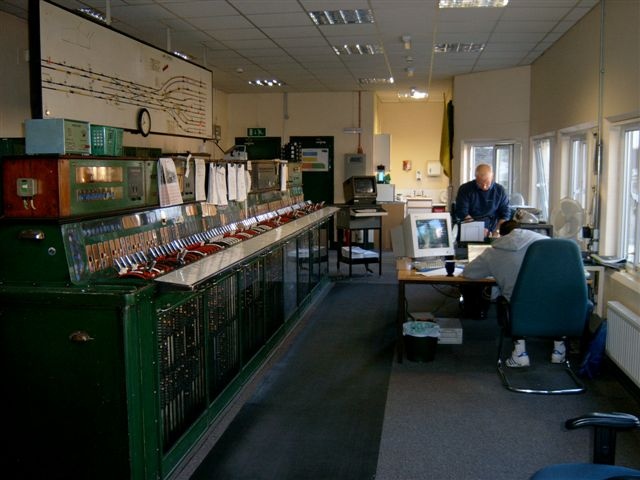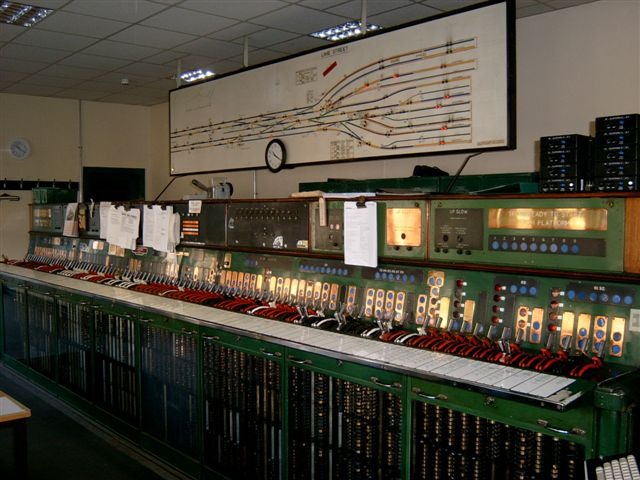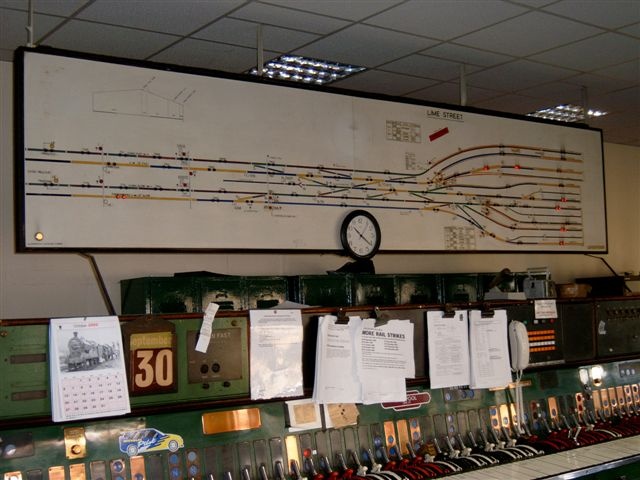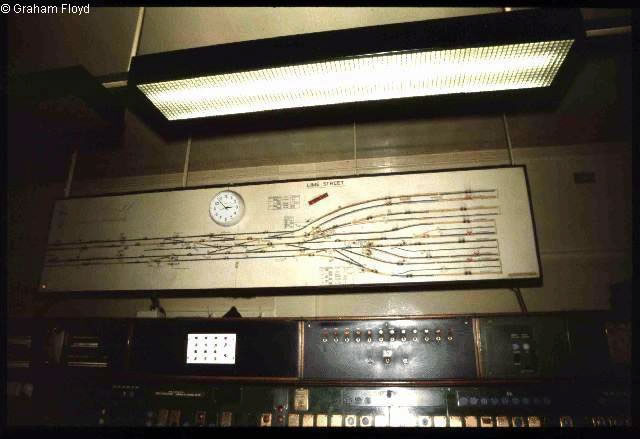Liverpool Lime Street signal box
Liverpool Lime Street signal box with its Westinghouse Brake & Signal Co. Ltd. Style 'L' Power Lever Frame was opened by British Railways on 25th January 1948. It was built to the London, Midland & Scottish Railway Type 13 design and was fitted with a 95 lever Westinghouse 'L' frame
When opened the adjacent box was Edge Hill No.2 box which was closed in August 1961 when Edge Hill Power Signalbox became the adjacent box which remains the situation today {June 2014}.
the signal box closed after the last train signal on 13 july 2018 shut completely 30 july 2018.

Pictured above is an external picture of Liverpool Lime Street signalbox, with kind permission of John Tilly taken on 5th May 2004, picture © John Tilly.
Below is the Westinghouse Brake & Signal Co. Ltd lever frame. The train describers sending boxes are fitted on top of the frame box whilst the receiving train describer units are housed between the signalling diagrams.

The frame is a Westinghouse Style 'L' Power Frame which is all electrically locked. The frame was formed of 8 x 12 way section which making a total of 95 levers, {8x12}-1 = 95 levers, as the last “lever” space is unavailable. 31 of these levers worked the points, 58 signal levers operated the coloured light signals, there were no special levers and 6 spare levers when the frame was supplied and installed. This made the working lever total of 89. The original order intended the frame to be 155 levers, but the use of selection reduced the lever count to 95 levers

Here we have the general view of the signal box and its lever frame from the left hand, lever number 1. The track diagram is clearly visible above the Westinghouse lever frame. Picture above by kind permission of James Mackenzie, © James Mackenzie taken 2002.

This time James has kindly pro vied us the frame from the high end lever numbers, notice the train describer above the lever indicators, Picture above by kind permission of James Mackenzie, © James Mackenzie taken 2002.

Another really good picture of the lever frame, again with the trains describers clearly prominent above the lever indicators. Picture above by kind permission of James Mackenzie, © James Mackenzie taken 2002.

General view of the interior of Liverpool Lime street signal box.
Picture above by kind permission of James Mackenzie, © James Mackenzie taken 2002.

A good close up of the lever leads, or lever description plates. Black levers are points, Red levers are signals, and white is a spare lever. Picture above by kind permission of James Mackenzie, © James Mackenzie taken 2002.

General view of the track diagram, showing the station layout, the 9 platform terminus station is on the far right of the diagram Picture above by kind permission of James Mackenzie, © James Mackenzie taken 2002.

Close up of the station area on the diagram.
Picture above by kind permission of James Mackenzie,
© James Mackenzie taken 2002.

General view of the signalbox interior in the mid 1980's, showing the complete set-up from the left hand end of the lever frame. The 4 railway tracks can be clearly seen on the approach to the station on the track diagram. Picture above by kind permission of Graham Floyd, © Graham Floyd

A middle distance photograph of the centre section of the signalbox and diagram. Behind the signalling levers one can see the glass roundels showed the signal aspect, being Red = Signal on and White = signal off. and for Distant signals Yellow = Distant Signal On / Off = Distant Signal Off. The flat indicators showed an 'N' and 'R' indication for points to show the points as having been detected in their Normal or Reverse position. The "F" light became lit when the points were free to move, with a White = Points Out of Correspondence. The odd grouped extrusions above groups of signal indications were route indications which lit on the frame when a route was set to confirm to the signalman that the correct route was set before he cleared the signal because the same signal lever cleared the signal for all routes. Picture above by kind permission of Graham Floyd, © Graham Floyd

A general view of the signalbox interior, showing the complete set-up from the right hand end, we can clearly see several trains in the platforms at the station. Picture above by kind permission of Graham Floyd, © Graham Floyd

Liverpool Lime Street diagram, with the platforms clearly visible at the right hand end of the diagram. Picture above by kind permission of Graham Floyd, © Graham Floyd
Adjacent boxes
The 1937 sectional appendix gives the adjacent box to Liverpool Lime Street box as being Edge Hill No.1 (1m 68yds away), the next box being Edge Hill No.2 (570yds away).Edge Hill No.1 box was closed on 5th July 1947 but the 1956 sectional appendix supplement still gives the distance between Liverpool Lime Street and Edge Hill No.2 boxes as 1m 638yds, this is despite both Liverpool Lime Street and Edge Hill No.2 boxes being replaced.
The 1960 sectional appendix gives the distance between Liverpool Lime Street and Edge Hill No.2 boxes as 1m 667yds which reflects the boxes being replaced. Whilst we know that Liverpool Lime Street was replaced in 1948. I am unaware of when Edge Hill No.2 box was replaced. It was a London, Midland & Scottish Railway Type 13 design which means it may have been a replacement as a result war damage, replaced at the same time as Liverpool Lime Street, or just replaced a life expired box. Thanks to David Ingham for this information.
